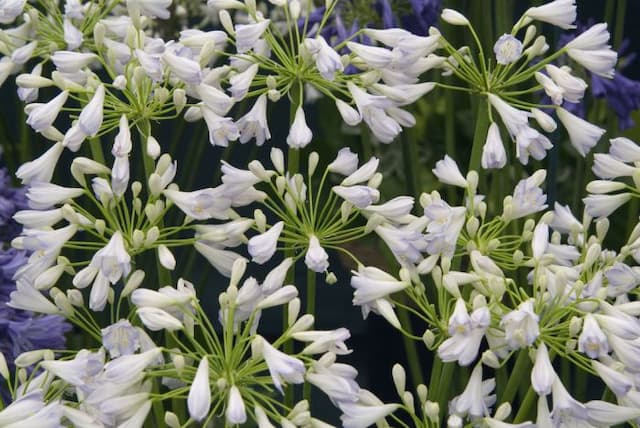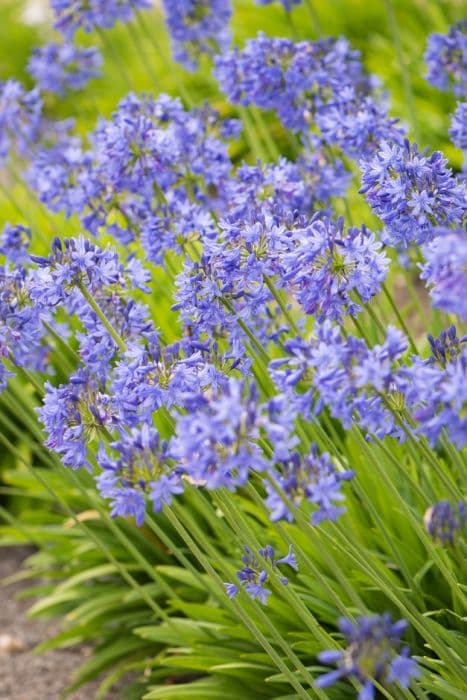Bell Agapanthus Agapanthus campanulatus subsp. patens

ABOUT
Agapanthus campanulatus subsp. patens, commonly known as the Bell Agapanthus, features a distinct appearance characterized by its lush, strap-shaped, glossy green leaves that form a dense clump. From the center of this foliage emerges a sturdy, upright stalk which is topped by a rounded cluster of attractive, bell-shaped flowers. These blossoms are typically a deep blue to violet color, though they can occasionally be found in white or lighter shades of blue. Each individual flower possesses a striking contrast with its darker, prominent stripes running down the center of each petal, providing a beautiful display above the green foliage. The Bell Agapanthus blooms during the warmer months, bringing a splash of vibrant color to gardens. It is particularly noted for its ability to attract birds, bees, and butterflies, which find the nectar-rich flowers irresistible. Despite its aesthetic appeal, it is important to note that this plant is recognized as being toxic if ingested, hence care should be taken around pets and small children.
About this plant
 Names
NamesFamily
Amaryllidaceae
Synonyms
Bell Agapanthus, Patens African Lily, Cape Blue Lily
Common names
Agapanthus patens F.M.Leight., Agapanthus praecox subsp. minimus F.M.Leight., Agapanthus praecox var. minimus (F.M.Leight.) F.M.Leight.
 Toxicity
ToxicityTo humans
The Agapanthus, also known as the African lily, can be toxic to humans if ingested. Ingesting any part of the plant can lead to symptoms such as nausea, vomiting, abdominal pain, and diarrhea. Contact with the sap may also cause skin irritation or an allergic reaction in some individuals. It is always advisable to handle plants with care and to keep them out of reach of children, who might accidentally ingest plant material.
To pets
The African lily is toxic to pets if ingested. Consuming parts of this plant can result in symptoms such as vomiting, diarrhea, and drooling in pets like cats and dogs. There is potential for more severe reactions such as tremors or an increase in heart rate if larger quantities are ingested. Pet owners should keep African lilies out of reach and consult a veterinarian immediately if they suspect their pet has ingested any part of the plant.
 Characteristics
CharacteristicsLife cycle
Perennials
Foliage type
Evergreen
Color of leaves
Green
Flower color
Blue
Height
2 feet [60 cm]
Spread
2 feet [60 cm]
Plant type
Bulb
Hardiness zones
8
Native area
South Africa
Benefits
 General Benefits
General Benefits- Aesthetic Appeal: Agapanthus, also known as the African Lily, adds visual interest to gardens with its tall flower stalks and attractive blue or purple blooms.
- Low Maintenance: Once established, the African Lily is relatively easy to care for, requiring minimal watering and pruning.
- Drought Tolerance: This plant is suitable for water-wise gardens due to its ability to withstand periods without much rainfall.
- Attracts Pollinators: The flowers of Agapanthus can attract bees and butterflies, contributing to pollinator health and biodiversity.
- Focal Point for Landscaping: The striking appearance of the African Lily makes it an excellent focal point in landscape design.
- Erosion Control: The African Lily's dense root system can help stabilize soil and prevent erosion, especially on slopes.
- Long Blooming Season: Agapanthus has a lengthy blooming period that ensures colorful displays throughout the summer months.
- Border and Container Planting: The plant is versatile and can be used in borders or containers for added flexibility in garden design.
- Cut Flowers: African Lily makes for beautiful cut flowers that can be used in floral arrangements, providing both indoor and outdoor decoration.
- Deer Resistance: Agapanthus is known to be deer resistant, which is beneficial for gardens in areas with high deer populations.
 Medical Properties
Medical Properties- This plant is not used for medical purposes
 Air-purifying Qualities
Air-purifying QualitiesThis plant is not specifically known for air purifying qualities.
 Other Uses
Other Uses- Agapanthus (African Lily) is often used as a source of blue and purple dyes, extracted from the petals of its vibrant flowers.
- The fibrous leaves of the African Lily are traditionally used in the creation of ropes and twines by several indigenous communities.
- The sap from the African Lily can be used as a mild adhesive for small-scale craft projects.
- In some cultures, dried Agapanthus flowers are used in potpourri mixtures for their subtle fragrance and aesthetics.
- The Agapanthus' sturdy stalks can be fashioned into informal garden stakes to support other plants.
- Reed-like qualities of the leaves allow them to be woven into decorative basketry or mats in skilled hands.
- The seed pods of the African Lily, when dried, are used in floral arrangements, adding an exotic aesthetic to bouquets.
- Agapanthus can be planted for soil erosion control due to its robust root system.
- In some regions, the leaves are used for thatching small structures or crafting temporary shelter materials.
- Due to its clumping nature, the African Lily is often used as a living fence or privacy screen in gardens.
Interesting Facts
 Feng Shui
Feng ShuiThe African Lily is not used in Feng Shui practice.
 Zodiac Sign Compitability
Zodiac Sign CompitabilityThe African Lily is not used in astrology practice.
 Plant Symbolism
Plant Symbolism- Love Letters: The common name for Agapanthus campanulatus subsp. patens is African Lily. African Lily is often associated with love letters or messages, due to the trumpet-shaped flowers which can be seen as a symbol of broadcasting emotions or sentiments.
- Beauty: The striking blue to violet flowers of the African Lily symbolize beauty and elegance, making it a popular choice in gardens and floral arrangements to enhance aesthetic appeal.
- Enduring Love: The robust and long-lasting nature of the African Lily's blooms is symbolic of enduring love and commitment, reflecting the plant's ability to thrive and blossom year after year.
 Water
WaterThe African Lily should be watered regularly while actively growing in spring and summer, aiming for once a week with about 2 gallons per watering for outdoor plants. It's important not to overwater, as this can lead to root rot, especially in the winter months when the plant's water requirements decrease. During the winter, reduce watering to every few weeks, just enough to prevent the soil from completely drying out. Ensure that the soil drains well to keep the root system healthy.
 Light
LightAfrican Lilies perform best in full sunlight to partial shade. They thrive when they receive at least 6 hours of direct sunlight daily, so placing them in a spot where they can soak up the morning sun with some afternoon shade is ideal. Avoid deep shade locations, which can lead to poor blooming.
 Temperature
TemperatureAfrican Lilies prefer a temperature range between 50°F and 80°F. They can survive minimum temperatures down to about 40°F; however, prolonged exposure to temperatures below this can damage the plant. The ideal growing conditions are warm days with cooler night temperatures, as extreme heat can stress the plants.
 Pruning
PruningPrune the African Lily after flowering by cutting back the spent flower stalks to encourage new growth. Deadhead regularly throughout the blooming period to promote continuous flowering. A more thorough pruning can be done in the late fall or early spring to remove old leaves and shape the plant, which helps to stimulate new growth and improve its overall health.
 Cleaning
CleaningAs needed
 Soil
SoilThe optimal soil mix for African Lily (Agapanthus campanulatus subsp. patens) should be fertile, well-draining soil with a pH between 6.0 and 8.0; a mix of loam, sand, and compost is ideal. Make sure to provide adequate drainage to prevent root rot, as they prefer not to sit in waterlogged soil.
 Repotting
RepottingAfrican Lily plants don't require frequent repotting and can be left in the same pot for several years because they bloom best when rootbound. Generally, repotting every 3 to 4 years is sufficient unless the plant has outgrown its container.
 Humidity & Misting
Humidity & MistingAfrican Lily appreciates moderate humidity levels but is quite adaptable. Aim for humidity levels similar to those found in a typical home environment, which usually ranges from 30% to 50%.
 Suitable locations
Suitable locationsIndoor
Ensure bright light, well-draining pot mix, and regular watering.
Outdoor
Plant in sunny spot, shelter from harsh winds, ensure good soil drainage.
Hardiness zone
7-10 USDA
 Life cycle
Life cycleAgapanthus campanulatus subsp. patens, commonly known as the African Lily, begins its life cycle when a seed germinates in the spring after a period of dormancy. The seedling develops a root system and foliage in the form of strap-like leaves. Over a few years, the plant matures and forms a rhizomatous clump that can spread underground. During the summer, the African Lily sends up flower stalks with showy blue or violet bell-shaped umbels that attract pollinators for sexual reproduction. After pollination, the flowers develop into capsules containing seeds which, when mature, are dispersed by wind or fall to the ground. The plant then enters a period of dormancy in winter, conserving energy for the next growing season.
 Propogation
PropogationPropogation time
Spring to Summer
Agapanthus campanulatus subsp. patens, commonly known as Lily of the Nile, can often be propagated through division which is typically done in early spring or fall. To propagate by division, a gardener can gently lift the clump of established plants from the soil, being careful to keep as many roots intact as possible. Next, the clump should be separated into smaller sections, each with a few shoots and a portion of root system. These sections can then be replanted at the same depth from which they were taken, spaced approximately 18 inches (roughly 45 cm) apart, to allow enough space for the plants to grow and mature. Water the new plantings thoroughly to help establish their roots in their new location.








![African lily [Brilliant Blue]](/_next/image?url=https%3A%2F%2Fplants-admin.emdemapps.com%2Fimages%2Fplants%2F%2Fimages%2F604b5e3c28e2b.png&w=640&q=75)
